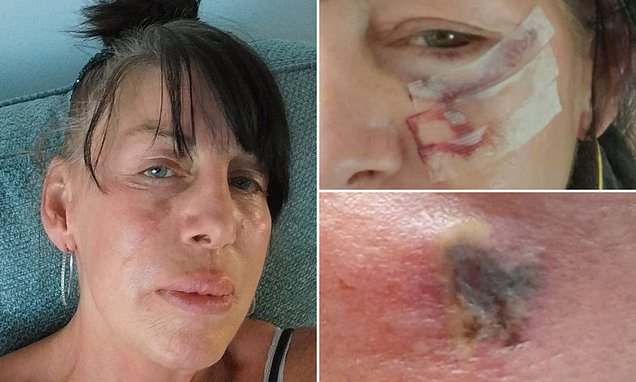Mother, 57, told her 'freckle' was eczema discovers blemish was cancer
Mother, 57, told her ‘freckle’ was eczema discovers blemish was actually stage-four cancer
- A mother-of-three said doctors initially treated her cancerous freckle as eczema
- Years after she first spotted the face freckle, a biopsy revealed stage four cancer
A mother was left shocked when she found out that a freckle on her face was stage four cancer.
Kay Wootten, from Romford in London, claims doctors initially attributed the mark, which appeared in 2018, to eczema.
The 57-year-old was prescribed steroids and moisturisers to treat the thought to be skin condition — before a biopsy in June 2022 revealed the cancer.
Following the examination, the retired healthcare assistant and mother-of-three was told she had stage four melanoma.
She has now been undergoing chemotherapy for 12 months and has had to have surgery to stop the disease from spreading further.

A mother of three was left shocked when she found out a freckle on her face was stage four cancer.

Kay Wootten was prescribed steroids and moisturisers to treat the thought to be skin condition – before a biopsy in June 2022 revealed the cancer
Kay said: ‘All this could have been prevented if they just listened to me when it started to change.
‘My whole life has completely changed — I try to joke it off but it’s really got me down.’
Kay said she first noticed the mark on her face in August 2018.
During lockdown, her symptoms worsened, and the freckle began growing, itching and bleeding – but she claims doctors continued to insist it was eczema.
In 2021, she was prescribed steroid and moisturisers which she used to no avail before finally putting her foot down in 2022 and insisted on a referral for a dermatologist.
Kay was then diagnosed with a stage four melanoma and has since had surgery and over a year of chemotherapy.

The 57-year-old has now been undergoing chemotherapy for 12 months after first noticing the mark in 2018


Kay, from Romford, has had to have surgery to stop the disease from spreading further
She said: ‘The first surgery I had was to remove the primary tumour and then they realised the margins around the tumour weren’t clear and still had cancer cells.
‘I had more removed, and the margins still weren’t clear — I’ve had four cheek lifts in front of and under my ear and had a lymph node removed as well.
‘I also had my thyroid removed as it was positive for melanoma.’
Kay claims she feels ‘ill all the time’ and ‘can’t do anything’ because of chemotherapy.
She added: ‘I feel like the next year is going to be a complete waste if they can’t get rid of it.
‘You don’t realise how much it affects your family as well. It’s not just you involved it’s your kids and you miss out on so much because of it.’
Kay’s medical centre and NHS North East London were approached for comment.
WHAT DO CANCEROUS MOLES LOOK LIKE? CHECKING IS AS EASY AS ABCDE
The more moles someone has, the higher their risk of developing melanoma.
The following ABCDE guidance can help people identify moles that might need looking over by a doctor.
Asymmetry
Look out for moles with an irregular shape.

Check for asymmetrical moles that have an irregular shape
Borders
Check for jagged edges.

People should look out for moles with irregular borders and jagged edges
Colour change
If a mole changes in colour or is a different colour in one part than in another, seek medical advice.

Moles that change colour or have a different colours within them should be looked over
Diameter
Any increase in size should be checked, but be particularly cautious of moles that grow more than around 6mm across.

Any change in size should be checked, but more than 6mm across is very concerning
Elevation
The E section is generally classed as ‘elevation’; warning you to watch out for moles that are raised from the surface, particularly if this is irregular.
Yet, Dr David Fisher, director of the melanoma program at Massachusetts General Hospital, explains many dermatologists have different classifications for this.
His preferred word is ‘evolving’.
Dr Fisher previously told MailOnline: ‘Is it changing? Do you notice anything suspicious or concerning? That is key.’

Look out for moles that are raised or those that ‘evolve’ over time
Source: Read Full Article
